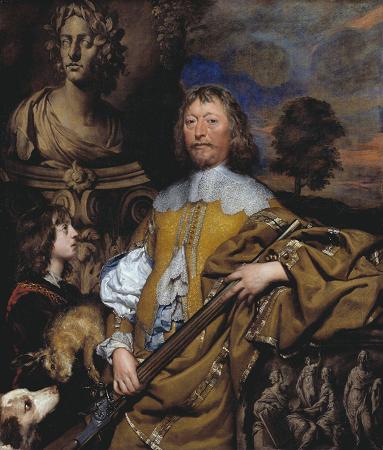John Michael Wright (1617 - 1694). John Michael Wright was a portrait painter in the Baroque style. Described variously as English and Scottish, Wright trained in Edinburgh under the Scots painter George Jamesone, and acquired a considerable reputation as an artist and scholar during a long sojourn in Rome. There he was admitted to the Accademia di San Luca, and was associated with some of the leading artists of his generation. He was engaged by Archduke Leopold Wilhelm of Austria, the governor of the Spanish Netherlands, to acquire artworks in Oliver Cromwell's England in 1655. He took up permanent residence in England from 1656, and served as court painter before and after the English Restoration. A convert to Roman Catholicism, he was a favourite of the restored Stuart court, a client of both Charles II and James II, and was a witness to many of the political maneuverings of the era. In the final years of the Stuart monarchy he returned to Rome as part of an embassy to Pope Innocent XI. Wright is currently rated as one of the leading indigenous British painters of his generation, largely for the distinctive realism in his portraiture. Perhaps due to the unusually cosmopolitan nature of his experience, he was favoured by patrons at the highest level of society in an age in which foreign artists were usually preferred. Wright's paintings of royalty and aristocracy are included amongst the collections of many leading galleries today. John Michael Wright, who at the height of his career would interchangeably sign himself Anglus or Scotus, is of uncertain origin. The diarist John Evelyn called him a Scotsman, an epithet repeated by Horace Walpole and tentatively accepted by his later biographer, Verne. However, writing in 1700, the English antiquarian Thomas Hearne claims Wright was born in Shoe Lane, London and, after an adolescent conversion to Roman Catholicism, was taken to Scotland by a priest. A London birth certainly seems supported by a baptismal record, dated 25 May 1617, for a Mighell Wryghtt, son of James Wright, described as a tailor and a citizen of London, in St Bride's Church, Fleet Street, London. What is known is that, on 6 April 1636, the 19-year-old Wright was apprenticed to George Jamesone, an Edinburgh portrait painter of some repute. The Edinburgh Register of Apprentices records him as Michaell, son to James W, tailor, citizen of London. The reasons for this move to Scotland are unclear, but may have to do with familial connections or the advent of plague in London. During his apprenticeship, Wright is likely to have lodged at the High Street tenement near the Netherbow Gate that served as Jameson's workplace. The apprenticeship was contracted for five years, but may have been curtailed by Jameson's imprisonment in late 1639. There is no record of any independent work by Wright from this period. It is also possible that Wright met his wife during his Scottish residency. Nothing is known of her, except from a statement of thirty years later which describes her as related to the most noble and distinguished families of Scotland. If this is accurate, it may explain how Wright was later able to find aristocratic patronage. All that is known for certain is that Wright had at least one child by her, a son, Thomas. There is evidence to suggest that Wright went to France following his apprenticeship, however his eventual destination was Italy. It is possible that he arrived in Rome as early as 1642 in the entourage of James Alban Gibbes, but he was certainly resident there from 1647. Although details of his time there are sketchy, his skills and reputation increased so much so that by 1648 he had become a member of the prestigious Accademia di San Luca. At that time, the Accademia included numbers of established Italian painters as well as illustrious foreigners including the French Nicolas Poussin and Spaniard Diego Velazquez. On 10 February that year he was elected to the Congregazione dei Virtuosi al Pantheon, a charitable body promoting the Roman Catholic faith through art, which hosted an annual exhibition in the Pantheon. Wright was to spend more than ten years in Rome. During that time became an accomplished linguist as well as an established art connoisseur. He also became prosperous enough to build up a substantial collection of books, prints, paintings, gems and medals, including works attributed to Mantegna, Michelangelo, Raphael, Titian and Correggio. He acquired some forty paintings-perhaps as much through dealing as collecting. Richard Symonds, the amateur painter and royalist, catalogued Wright's collection in the early 1650s.
more...







